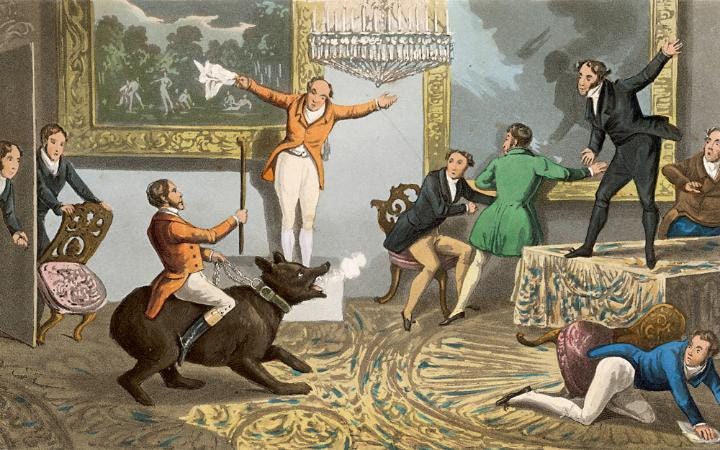The reason I had no “real” posts this last week, and two podcast posts, was I WAS REALLY BUSY.
Stopping by Manhattan
I was down in the Wall Street area to do a bit of business, so I stopped by the Battery:
Most of the Battery is currently under construction…
So I don’t have much to show you from the Battery right now.
But I do have something to show you from Wall Street, though it’s old:
So no, I am not writing about the return of Jon Stewart to the Daily Show. I’m talking about that deeply pitted stone wall.
It’s been like that for over 100 years.
Unsolved Wall Street Bombing - from 1920
The lunch rush was just beginning as a non-descript man driving a cart pressed an old horse forward on a mid-September day in 1920.
He stopped the animal and its heavy load in front of the U.S. Assay Office, across from the J. P. Morgan building in the heart of Wall Street. The driver got down and quickly disappeared into the crowd.
Within minutes, the cart exploded into a hail of metal fragments—immediately killing more than 30 people and injuring some 300. The carnage was horrific, and the death toll kept rising as the day wore on and more victims succumbed.
Who was responsible? In the beginning it wasn’t obvious that the explosion was an intentional act of terrorism. Crews cleaned the damage up overnight, including physical evidence that today would be crucial to identifying the perpetrator. By the next morning Wall Street was back in business—broken windows draped in canvass, workers in bandages, but functioning none-the-less.
….
Based on bomb attacks over the previous decade, the Bureau initially suspected followers of the Italian Anarchist Luigi Galleani. But the case couldn’t be proved, and the anarchist had fled the country. Over the next three years, hot leads turned cold and promising trails turned into dead ends. In the end, the bombers were not identified. The best evidence and analysis since that fateful day of September 16, 1920, suggests that the Bureau’s initial thought was correct—that a small group of Italian Anarchists were to blame. But the mystery remains.
People forget the real anarchists from over 100 years ago. They had far more violence than the weenies who play-act at being anarchists now. A lot of this died out first with the rise of Mussolini in Italy (which squashed the Italian anarchists, who were the main anarchist groups) and then totally obliterated with World War 2.
Related links:
Wikipedia article: Wall Street bombing
PBS: The Bombing of Wall Street
Opera Interlude: Mozart Trio
I saw Opera Daily covered the notable trio from Cosi fan Tutte today:
The top opera composer, simply, is Mozart. Especially in his ensemble composition.
Cosi fan Tutte, in many ways is “problematic”, as the kids like to say. But anybody going to opera for the plot is like going to a Michael Bay movie for its deep characterizations.
This trio has weaving voices, evoking summertime waves wafting ships off to sea…. and it’s just plain gorgeous.
Here is another version with English subtitles:
People Who Died Too Young
One of my current favorite podcasts is Stuff You Missed in History Class:
This past week, two people they profiled are men who died very young, one as a direct result of his behavior (Mad Jack Mytton died from his heavy drinking at the age of 37) and the other from disease from what I would call a difficult life.
But these back stories, and not the main stories, are in the “Behind the Scenes Minis”, which have become my favorite parts of this podcast:
So there are two connections of the men that tickled my brain — Mad Jack Mytton reminded me of Terry Pratchett’s bits on various Discworld aristos doing crazy things (specifically Lady Sybil’s family’s forebears) and being loved by the locals as a result. Because Mad Jack Mytton was doing completely reckless things (like bringing a bear into his house) and doing the stereotypical literary “can you believe the crazy things rich people do?!” that you assume is just made up.
But yeah, he did it.
And some people loved him.
He died at the age of 37. People tried to save him from himself…. but yes, he essentially drank himself to death.
George Washington Williams, on the other hand, seems to have run around trying a bunch of things (not recklessly, per se), trying to make an impact, but perhaps getting into scrapes due to overreaching on his part, and others trying to exploit him. One of the most interesting episodes was how he went to the Congo, unauthorized by the sole power, King Leopold II (and that was a weird situation).
Then he wrote an account of the abuses he saw there…. but due to his death at age 41, his contributions were forgotten. Others came after him to expose the abuses under Leopold’s regime, and it’s mainly due to a 20th-century historian that we currently know about George Washington Williams’s work.
As many have said, his life would make a great movie — he was in the U.S. Civil War in the Union Army (he was too young but got in), went to Mexico to continue fighting (trying to overthrow Emperor Maximilian), was part of the Buffalo soldiers out West, became wounded and then went to college and became a minister.
That’s just the beginning. He tried a lot. They could pick all sorts of things to put into a movie, a TV series, a miniseries — take your pick. So far, his only appearance as a character in media is being played by Samuel L. Jackson in a not-very-good Tarzan movie.
It seems to me he deserves better than that.












I agree, the historical record has been carefully crafted to dim the light on notables.